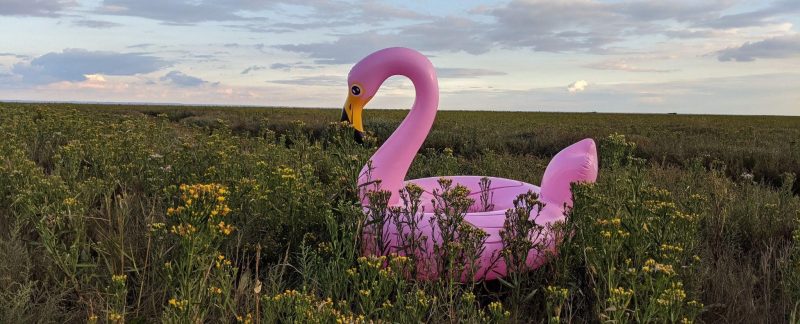Monday 6 September
On Monday the team started to gather properly around lunch time as plans had been made to try for a catch of Grey Plover at Gedney that evening. Cathy had been at the Norfolk base for a couple of days so the house was well set up and ready for everyone to arrive, which soon included Tim, and they got the ‘party tent’ up and ready outside. Katharine arrived next followed by Caroline and Hilary and soon Steve, Alex, Luke, Sarah and Chris were also there. Tents were put up by those who needed them and a baked potato lunch was well appreciated by all (thank you Cathy!). The net set was sorted out for the evening’s catch and, once Sabine arrived, the team headed off to Gedney around 2.20 pm meeting Richard, Ryan and Lizzie there. The single net was set out on the pool identified at the previous Wash week and soon the team was waiting under a tarp for the tide to bring the birds in. Sadly the birds just weren’t quite settled and, with the tide in, the team had to give up for the day and headed home to dinner. During dinner it was confirmed that the licensees thought it was worth a second try at Gedney in the morning so soon everyone headed to bed.
Tuesday 7 September
The team got up to leave for Gedney at 4:30 am and were under the tarp soon after 5:15 am. The birds did appear and move into the catching area with around 40 present at most but ~15 were in safety and three stayed behind the net meaning that there was never a good opportunity to fire. Water soon came in as well and came in as a wave rather than down the creek! The birds seemed to move up out of a slightly deeper hollow in front of the net but whilst there was a nice small catch of 15 Grey Plover and six Bar-tailed Godwits, the area was soon underwater so the decision was made to pick up the net set and head back for breakfast cooked by Louise and Lizzie.
Richard spent some time during the morning recceing beaches on the Norfolk side as well as Ken Hill. On Snettisham beach there were groups of 50 or 60 Sanderling which were quite jumpy as they were often disturbed so didn’t form a strong nucleus. As the tide rose any birds moved up towards Heacham where they met more walkers but Richard counted a total of 400–450 meaning there might be some options another day (though he said he ‘was not filled with joy’). In addition to the Sanderling, some 30 Turnstone (lots of juveniles) plus Ringed Plover and Oystercatchers were around. No Curlew and few Oystercatchers moved about as the marsh hadn’t fully flooded out lower down but some Sanderling were again by the sailing club.
Evening plans were discussed and a decision was made to try for Wainfleet islands again. No recces had been made as the mornings and evenings are quite different for bird movements, but it was well worth a try. Three small mesh half nets were packed ready to head round. Two nets would be set on the southern shingle edges and one north where Grey Plover had been seen on the previous trip. The team then left at 1:45 pm to drive round to Lincolnshire and, after a picnic dinner at 3:15 pm, were out on the island at 4:30 pm to be under the tarp by 5:15 pm. Birds did eventually come in, but the best option sadly ended up with a misfire (middle net of the three set) and, though some additional twinkling was tried whilst the team lay flat on the marsh, the tide came in too high and we had to pick up. The kit was all carried off the saltmarsh and everyone bar Steve left to get some sleep as it was decided to try for Sanderling at Heacham South the next morning. Steve was camping next to the Horseshoe to recce there the next morning and to look for Redshank colour flags at Freiston.
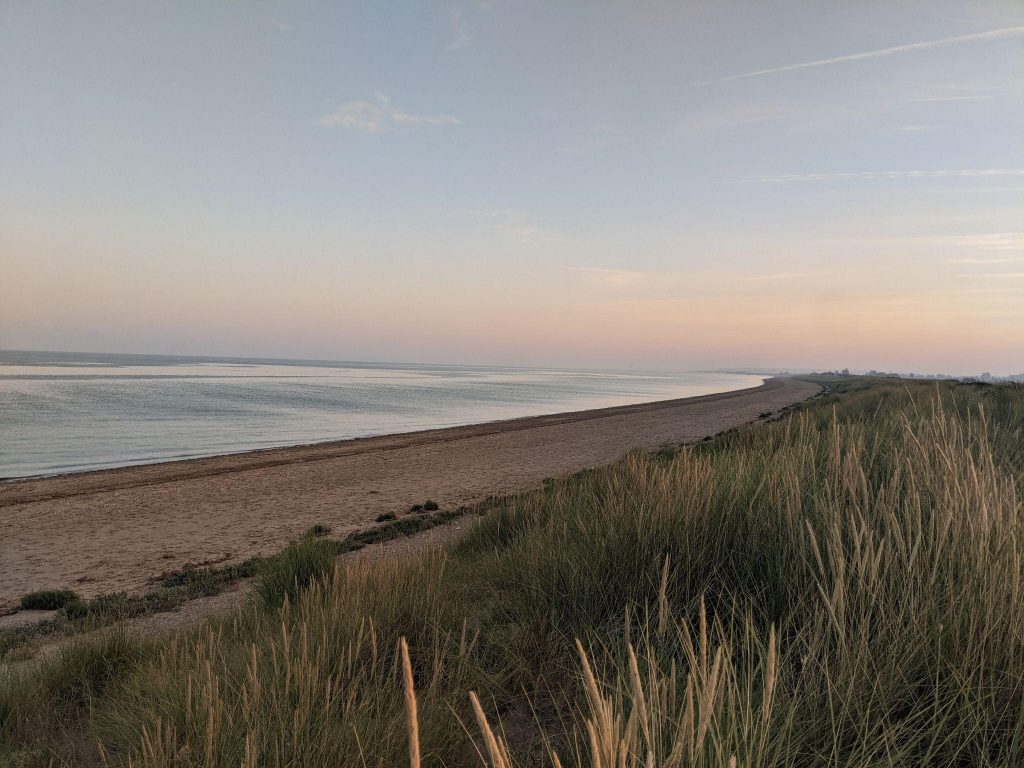
Wednesday 8 September
The team was up at 4:15 am to leave at 4:45 am and the nets were all set by 6 am (despite a couple of small hitches with kit). Cathy, Luke, Chantal and Chris were sent out long stopping and twinkling, meaning they got a good view of the nets which were fired successfully by Richard when the birds moved nicely up into place. The catch totalled 189 Sanderling and eight Dunlin and soon ringing and processing was all go, with a few people stopping to do some public relations. Lots of retraps were great to see, including one which turned out to have been ringed nine years ago and another which was only the 25th Norwegian-ringed Sanderling reported in Britain!
Carole and Bernard had arrived and, though not staying at the base, were out doing resighting along the Norfolk coast. During the catch Guy was recceing south from the catch site down to Sandringham and Lizzie went out to look at Ken Hill. No other good flocks were seen, but there was a flagged Curlew spotted (Flag = AA). Once all the birds were processed the team headed back for breakfast – thank you again Louise and Lizzie.
Heacham South (cannon netting)
| Species | New | Retrap | Total |
| Sanderling | 140 | 40 | 180 |
| Dunlin | 8 | 8 | |
| Totals | 148 | 40 | 188 |
Conversations between Steve and Richard resulted in a decision to try for the Horseshoe tomorrow morning and so Steve set a net there and the team would drive round early to meet him there first thing. Guy had seen some good numbers of birds on the saltmarsh pools south of the pits including 200 Curlew, up to 1,000 Dunlin plus Grey Plover and Bar-tailed Godwit, though a Merlin was hassling some of them at high tide. It looked good for mist netting later in the week and some small birds were using the fields behind. No adult Curlew flocks or groups were seen, but Lizzie spotted two headstarted Curlew on Ken Hill, including one with a GPS device.
Various jobs were then carried out at the base (data-checking, packing kit etc.) and Lizze, Lou, Sabine, Alex and Caroline put together a lasagne dinner with Eton mess pudding for everyone. Richard and Guy talked with Nigel about plans for mist netting at Wolferton whilst a small group headed out to do some resighting at Snettisham and the pits (Ryan, Katharine, Sabine, Caroline, Hilary and Chris). They didn’t have many Knot or Curlew there but were able to read a lot of the Bar-tailed Godwit roosting south of the sailing club so the outing was a success! The Knot flocks were also spectacular.
Thursday 9 September
The team got up at 4:45 am and having left at 5:15 am they were ready at the Horseshoe by 6:30 am. Moving round the outside of the seawall, base camp was smoothly in position whilst Steve, Lizze, Caroline and Hilary watched from the cars (plus took some video of the seven-cannon net). Lots of Oystercatchers and small waders were around, with some 1,000 Godwits nearby and the only issues were a sleeping Ringed Plover and a few others to be jiggled. A catch was made soon after 8 am with the new net design firing well and soon everyone was very busy extracting the Oystercatchers, Dunlin and a few Grey Plover and Turnstone. Ringing and processing was soon underway and, although a small number of birds were ringed and released, all birds were processed in time. The team then headed off once packed up (and a lost mobile found!) to the roadside café down the road for an excellent cooked breakfast!
Horseshoe Lagoon (cannon netting)
| Species | New | Retrap | Total |
| Oystercatcher | 216 | 20 | 236 |
| Dunlin | 121 | 121 | |
| Knot | 6 | 6 | |
| Grey Plover | 4 | 4 | |
| Turnstone | 4 | 4 | |
| Totals | 351 | 20 | 371 |
The evening’s plans were to mist net on both sides of The Wash, so most of the team went back to Norfolk to set Curlew nets for the morning (Lou and Guy) and Terrington mist nets. A small team (Steve, Katharine, Chantal and Chris) stayed at the Horseshoe to get ready to set mist nets on the Lincs side at Friskney pools.
The Lincs mist nets started slowly (though a new bird for them all was had when an inflatable flamingo was spotted on the saltmarsh!) but soon was busy with a nice variety of birds culminating with a Little Grebe caught at midnight when taking down the nets! All bar Steve then drove back to the base to get ready for the Curlew catch in the morning.
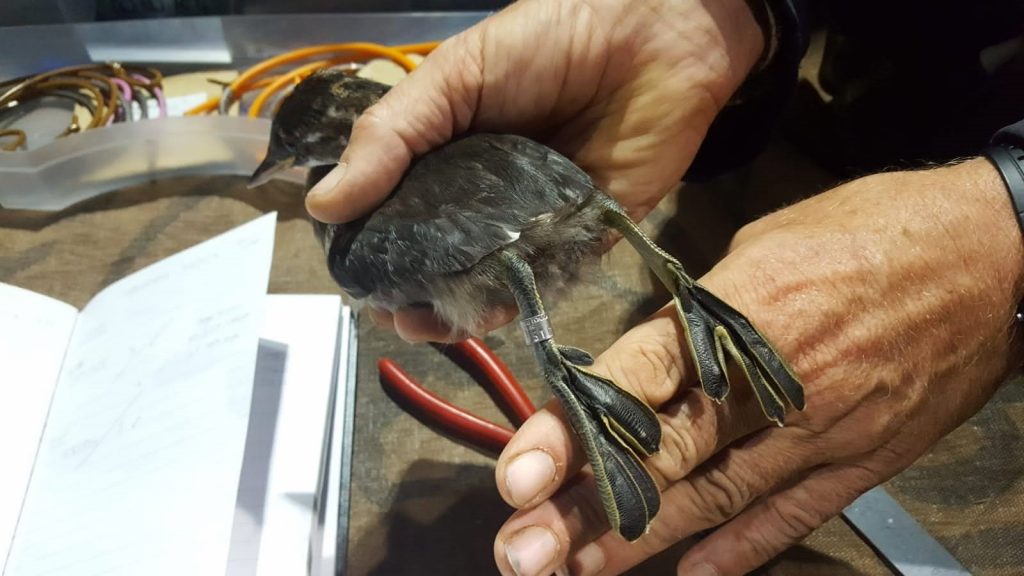
The Norfolk mist netting was at Terrington just out from the White Barn. They had a similar night to Lincolnshire with 46 birds caught but this did include a Green Sandpiper. Rachel arrived late the same evening at the Norfolk base as she was keen to be involved in the planned Curlew tagging.
Terrington Marsh
| Species | New | Retrap | Total |
| Redshank | 30 | 1 | 31 |
| Dunlin | 9 | 9 | |
| Ringed Plover | 2 | 2 | |
| Black-tailed Godwit | 2 | 2 | |
| Knot | 1 | 1 | |
| Green Sandpiper | 1 | 1 | |
| Totals | 45 | 1 | 46 |
Friskney Marsh
| Species | New | Retrap | Total |
| Bar-tailed Godwit | 12 | 1 | 13 |
| Curlew | 2 | 2 | |
| Oystercatcher | 1 | 1 | |
| Knot | 2 | 2 | |
| Redshank | 7 | 7 | |
| Turnstone | 2 | 2 | |
| Dunlin | 16 | 1 | 17 |
| Little Grebe | 1 | 1 | |
| Totals | 43 | 2 | 45 |
Friday 10 September
The Norfolk mist netters were up at 5:45 am to leave for the Curlew catch at Sandringham. The Lincolnshire mist-netting team joined a little later with Richard and they bumped into Nigel at 8 am when they were sent out to search for Curlew in other fields and areas. Some Curlew were spotted in the Ken Hill wet field by the team in Richard’s car (four birds) but with only one Curlew catchable the main team decided to give up and head home for breakfast. Steve went to resight at Freiston before coming round to join everyone else.
After discussions, we made the decision to try and set a net on the Ken Hill wet field and then mist-net at Wolferton with a fish and chip dinner planned. Sadly net setting failed at Ken Hill due to inaccessibility around the deep water filled ditches but Lloyd was positive about being able to get some temporary bridges for us in future. Lizzie, Ryan and Cathy, who were helping on Ken Hill, went to pick up the fish and chips and everyone met at Wolferton near the mist nets. Dinner was swiftly eaten (as tasty) and whilst the first set of people went out to check the nets those on the Curlew-tagging list had a demo from Nigel on how to fit a GPS tag. There weren’t a huge number of birds out on the marsh (though the highlight was a Spotted Redshank caught by the pools), but large numbers appeared to be further south near to the old pools that hadn’t been used for a while – Nigel and Tim went to investigate these and hopefully we will try them in future. The team then packed up and headed home to bed.
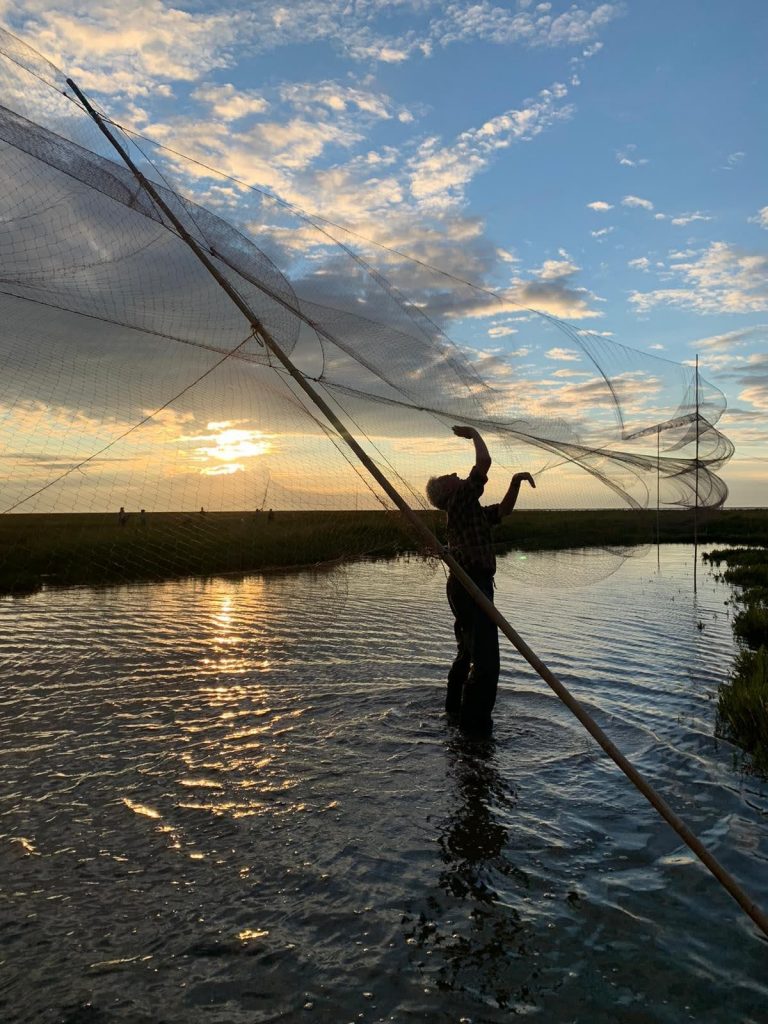
Wolferton Pools (new)
| Species | New | Retrap | Total |
| Dunlin | 7 | 1 | 7 |
| Black-tailed Godwit | 5 | 5 | |
| Ringed Plover | 3 | 3 | |
| Redshank | 2 | 2 | |
| Grey Plover | 1 | 1 | |
| Spotted Redshank | 1 | 1 | |
| Totals | 19 | 1 | 19 |
Saturday 11 September
A slightly later start for the main part of the team this morning as the hide crew got up at 6 am to leave at 6:30 am whilst the rest were on a 7 am for 7:30 am departure. When base camp arrived, the hide team reported that there were four Curlew in the field who had briefly been in the catching area, but walked out before their ages could be confirmed. After a little while Rachel’s car was sent out to twinkle/observe in the field and three Curlew were found to still be around which moved around the field a little though not perfectly into the catching area. Then in a sudden rush the birds moved up next to the net with two cacheable (including a suspected adult) so Steve took the catch and there was a quick dash to get the two birds out. Sadly, it seemed the ‘adult’ was actually an unringed juvenile but on a positive note the other bird was one of the headstarted birds (Yellow flag CX) which was doing very well.
Other recces had been happening at the same time with Nigel and Lizzie at Wolferton, Ryan at Freiston, Phil at Terrington pools, and Richard and Chantal at Gedney. There had been good flocks of Curlew and other things at the old Wolferton pools. Richard and Chantal saw a good number of Grey Plovers and Godwits at Gedney.
After processing the two Curlew, the team headed back for breakfast (thank you Alex who stayed home to make it), though six people were left to check the Wolferton pools up close. After breakfast plans were made for the last two days which mainly included one more try at Gedney plus mist-netting at Terrington and Freiston this evening.
Sandringham North Field
| Species | New | Retrap | Total |
| Curlew | 1 | 1 | 2 |
| Totals | 1 | 1 | 2 |
The Freiston side left at 3:30 pm and 4:30 pm to be set by 7 pm with a salad tea. They had two lines of nets out (one slightly more interesting than usual with a two-foot cliff fall at the end!) and from the 12 nets got a total of 85 birds. Including a good catch of Redshank, which were colour-marked. The Terrington side carried out a few extra jobs around the base (data checking and loading trailers etc) before the setting team left at 4:45 pm. The White Barn nets were set easily by a small group before heading back for dinner, though Katharine was left to watch the nets (with a delicious, packed dinner). The rest of the team arrived at 8 pm for a good session with 109 birds in total. The bulk of these came in during the first round, 20 minutes after the tapes were put on. Both teams finished off close to midnight and headed home ready for the Gendey catch in the morning.
Terrington Marsh
| Species | New | Retrap | Total |
| Black-tailed Godwit | 16 | 16 | |
| Redshank | 56 | 56 | |
| Dunlin | 28 | 28 | |
| Knot | 7 | 7 | |
| Ringed Plover | 1 | 1 | |
| Turnstone | 1 | 1 | |
| Totals | 109 | 0 | 109 |
Freiston Shore
| Species | New | Retrap | Total |
| Redshank | 53 | 53 | |
| Dunlin | 17 | 17 | |
| Black-tailed Godwit | 8 | 8 | |
| Turnstone | 4 | 4 | |
| Knot | 3 | 3 | |
| Totals | 85 | 0 | 85 |
Sunday 12 September
Everyone was up at 6 am for a 6:30 am departure and the net was set by a smaller team whilst the rest put out basecamp by 8 am. In the next half hour only a lone Greenshank was around, but a Spotted Redshank was heard calling when it flew over. Redshank and Grey Plover did come into the area but didn’t land quite right on the pool to be caught, possibly due to being spooked by a harrier that flew past earlier. As the tide rose, more birds arrived, but again on the wrong side of the pool and got spooked by some egrets this time before flying round to a small island nearby. There was a good period when 300–400 birds were around with up to 80 Grey Plover catchable but the opportunity to catch never arose and, with another flyby by a harrier, the decision was made to pack up and head back for breakfast as the net was under water. A shame but one of these days those pools will succeed!
Ideas were bandied around of a five-cannon net with eight-yard jumps, or to possibly build a wall on the saltmarsh to put the net on, or a short net to lift more easily but no firm decisions were made.
The majority of the team then had to leave for home (and work) the next morning but Steve, Cathy, Carole and Bernard stayed for a final mist-netting session at Gedney. They had a very good night given the small team with 121 birds caught in total – well done all!
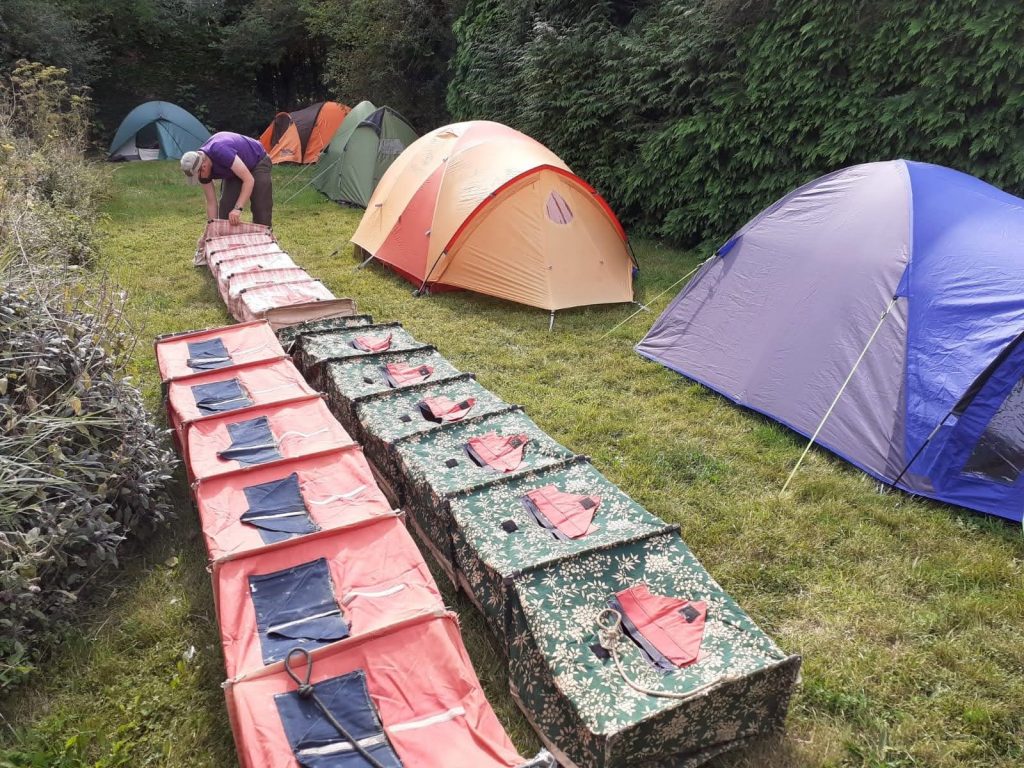
Gedney Marsh
| Species | New | Retrap | Total |
| Bar-tailed Godwit | 7 | 7 | |
| Redshank | 24 | 1 | 25 |
| Grey Plover | 22 | 1 | 23 |
| Ruff | 1 | 1 | |
| Knot | 19 | 19 | |
| Dunlin | 44 | 1 | 45 |
| Turnstone | 1 | 1 | |
| Totals | 118 | 3 | 121 |
Thanks for all for a great week and hope to see you all again soon!
Trip Ringing Totals (6 to 12 September)
| Species | New | Retrap | Total |
| Bar-tailed godwit | 19 | 1 | 20 |
| Black-tailed godwit | 31 | 31 | |
| Dunlin | 250 | 3 | 253 |
| Green Sandpiper | 1 | 1 | |
| Grey Plover | 27 | 1 | 28 |
| Knot | 38 | 38 | |
| Oystercatcher | 217 | 20 | 237 |
| Redshank | 172 | 2 | 174 |
| Ringed Plover | 6 | 6 | |
| Sanderling | 140 | 40 | 180 |
| Curlew | 3 | 1 | 4 |
| Turnstone | 12 | 12 | |
| Spotted Redshank | 1 | 1 | |
| Ruff | 1 | 1 | |
| Little Grebe | 1 | 1 | |
| Totals | 919 | 68 | 987 |
Resighting
Resighting took place on most days on both the Lincolnshire and Norfolk sides of The Wash. The main focus on the Lincolnshire side was to resight WWRG colour-marked Redshank at Freiston Shore and Frampton Marsh. On the Norfolk side the main focus was to resight WWRG colour-marked Curlew and Bar-tailed Godwit as part of the on-going survival rate analysis, with the majority of the resighting being carried out on Snettisham beach, Snettisham mudflats and Wolferton Pool. Time was also spent in the hides at Snettisham Pits searching for colour-marked Knot amongst the high tide roost as part of the combined project of Knot ringing and resighting in the UK and abroad.
September Resighting Totals (6 to 12 September)
| Species | Sightings | Individuals | WWRG | Non-WWRG |
| Curlew | 104 | 86 | 78 | 8 |
| Bar-tailed godwit | 76 | 62 | 61 | 1 |
| Redshank | 6 | 6 | 6 | 0 |
| Knot | 19 | 18 | 1 | 17 |
| Turnstone | 6 | 6 | 6 | 0 |
| Black-tailed Godwit | 19 | 18 | 0 | 18 |
| Oystercatcher | 3 | 2 | 0 | 2 |
| Dunlin | 1 | 1 | 0 | 1 |
| Spoonbill | 1 | 1 | 0 | 1 |
| Mediterranean Gull | 14 | 12 | 0 | 12 |
| Totals | 252 | 212 | 152 | 60 |
Interesting Sightings
Curlew included seven birds from the Norfolk headstarting project, resighted at Ken Hill, Snettisham mudflats and Wolferton Pool.
Knot resightings comprised birds from the following areas: The Wash – WWRG (1), Norway (4), Iceland (4), north-west England (7) and The Netherlands (2).
The single Dunlin was colour-marked at Filey Bird Observatory on 8 August 2021.
Black-tailed Godwits included birds from France (1), Portugal (1), Iceland (4) and Spain (2).
Resightings of non-waders included a Spoonbill, ringed in The Netherlands, and a grand total of 12 Mediterranean Gulls from several European countries including France, Belgium, Germany, Hungary and the Czech Republic.

